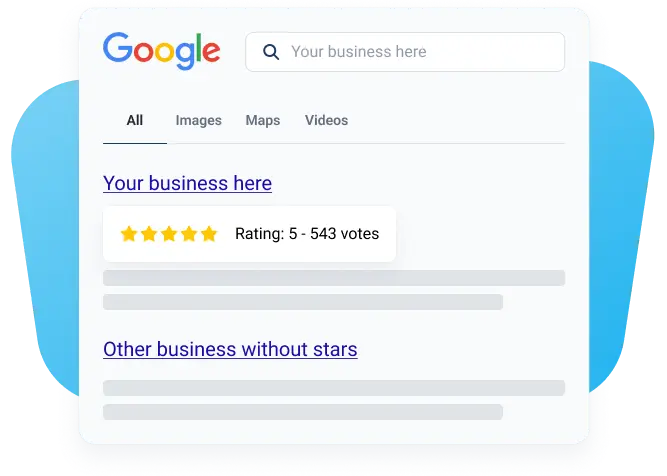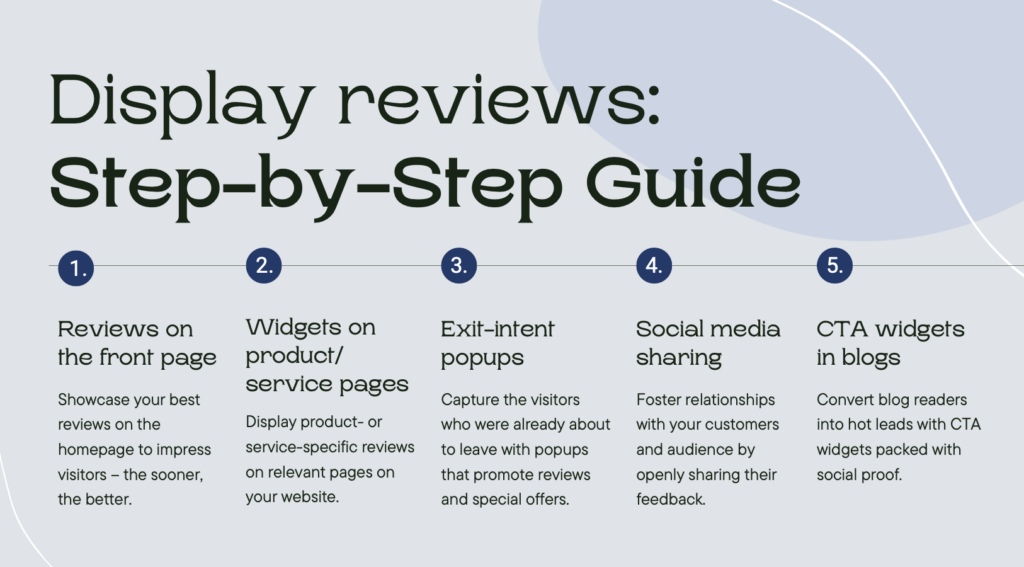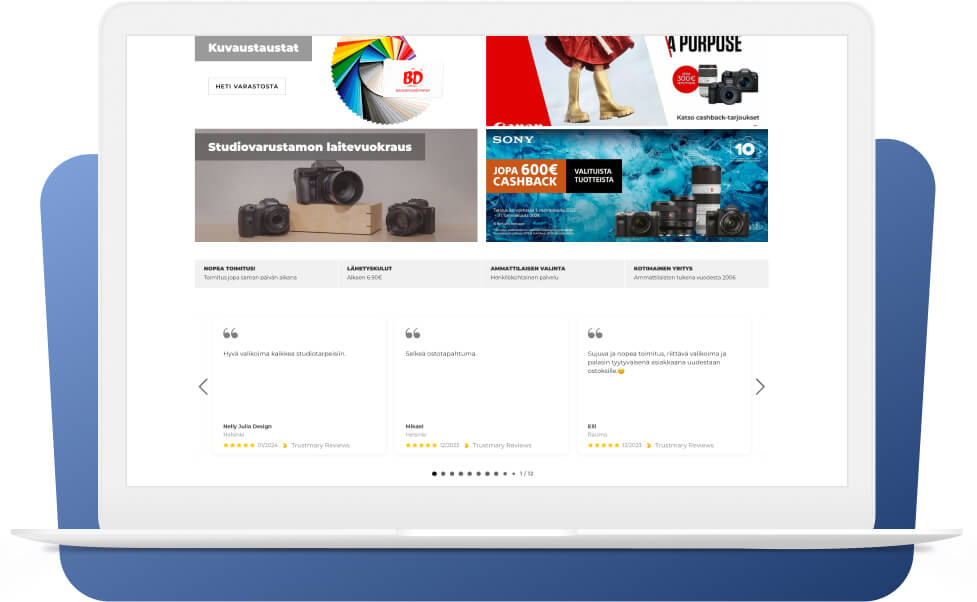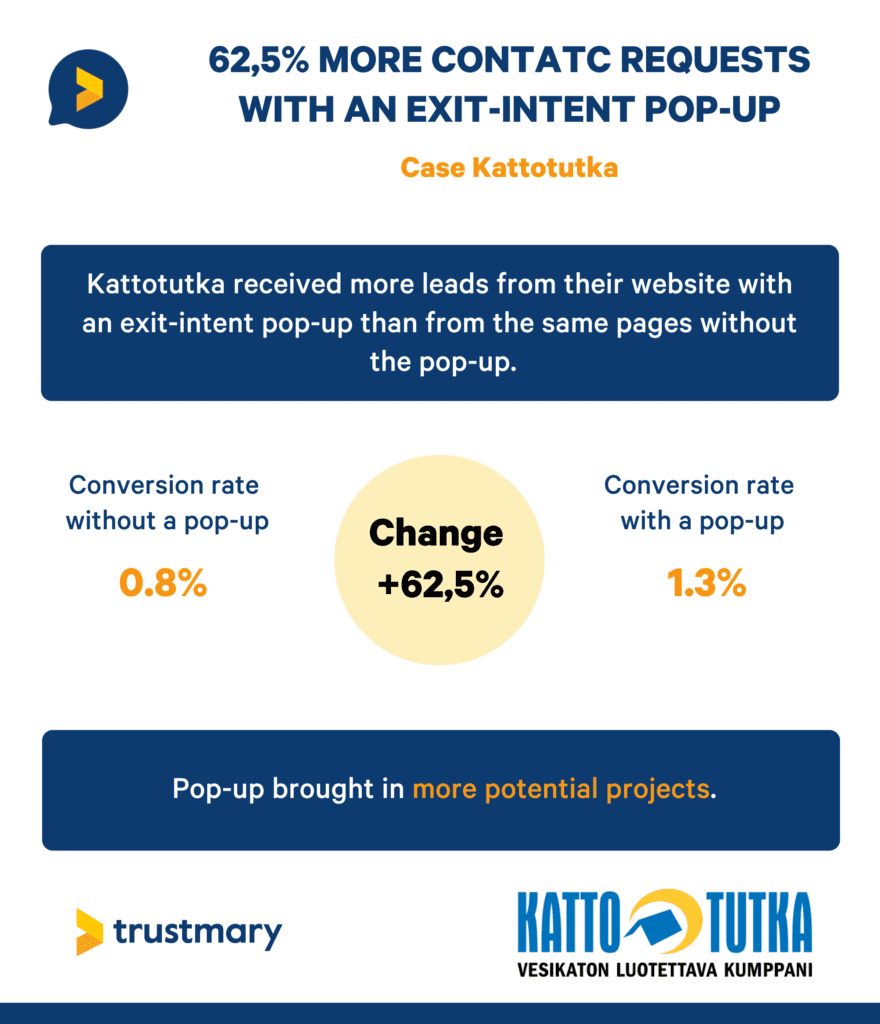Where to Showcase Customer Reviews on Your Website

Having a list of the most strategic places where to showcase customer reviews on your business website can increase your sales tenfold.
Did you know that 93% of shoppers suggest that online reviews impact how they shop?
As some of the most valuable pieces of data, your business can have, customer reviews bring in a larger audience, boost your online ranking, and speak to your brand's reputation.
Let's start by answering the most common question people have.
Where to Put Reviews on Website?
- Home page
- Product and services page
- Pricing page
- About us
- Contact page
- Dedicated testimonial page
- CTA widgets that direct to book a meeting, start free trial, or buy
- Exit-intent popups everywhere where people are just about to convert, but back out
Why add all your best reviews to all these landing pages?
First of all, you want to get more people on your website, and that's where review schema comes in handy.
The review schema markup is created per landing page, not per domain. Adding it will have a significant impact on your search engine performance.
This picture below clarifies what review schema markup is in practice: Adding a star rating to your search engine results for specific keywords.

Second of all, having reviews widget as an integral part of your website ensures a better conversion rate.
Outside of your website, remember to share reviews and client testimonials on social media as well.

Let's dive deeper into those different spots and how to make the most out of them with effective testimonials.
7 Strategic Places to Showcase Customer Reviews on a Website
Proper placement shares the positive experiences your customers have with potential buyers without them having to search for testimonials.
By using these seven strategic placements, you'll see how these powerful tools can greatly increase your bottom line.
1. Home Page
Your website's home page is one of the top locations to put all your marketing materials.
Also known as a landing page, this part of your site is likely the most visited page. As such, you'll want to make sure potential customers get all the information they need to make informed decisions when making a purchase.
This page is an iconic location for testimonials because everyone will see the feedback. Whether someone's simply interested in your brand or looking to make an actual purchase, the testimonials are front and center.
A company selling and renting photography equipment has added reviews as the next element after the hero element on their homepage.
I added our customer feedback to be almost the top element because it’s important to showcase as early on as possible that our reviews and testimonials are recent.
Henri Ilanen, Store Manager @Studiovarustamo
This is not to please search engines, but displaying reviews can make even more people buy.

A slider on the home page is one of the top areas to consider for sharing customer quotes and testimonial examples. With this, you won't take up too much space but still deliver valuable information in a small section.
You can pair the customer quotes with a hero image 🦸 or a call-to-action to bring it to life.
Such a display will capture the attention of site visitors instantly and also guide them to take the action you want from them.
The above example is made with Trustmary's Google Review Widget, and it features all our own Google reviews.
Without having to add your Google business reviews API!
2. Product and Service Pages
Your website's product and service pages are the second most important place to consider putting personal recommendations and customer quotes.
These pages are often visited by people interested in seeing what products you have to offer.
Did you know that in order to get those product reviews to possibly show on search engines, you need to add review schema to each landing page?
That is the only way to get those five star reviews to show up. It can be a tedious process, but Trustmary is a free tool that eases the process tremendously.

Adding review markup to important landing pages makes it possible (but not guaranteed, as Google will be Google...) for them to appear in Google search.
Convince Target Audience with Positive Customer Feedback
If you can share positive feedback in depth with potential customers, it could entice them to put through an order rather than window shop on your site.
Did you know that 88% of shoppers suggest testimonials are equally as trustworthy as personal recommendations from friends and family? 😱
That is why it's essential to put your brand in a positive light on the pages where people can choose to add your services or products to their carts.
One of the most important tips to note when adding customer quotes and feedback on product pages is to place them well. You won't want them to be too large, or they could take away from the product information on the page.
You can create small widgets to showcase customer satisfaction or dedicate a specific spot near the top or bottom of the page to share detailed customer stories.
3. Exit Popups
Exit popups are an essential part of the customer journey, especially if you want to retain a more significant chunk of shoppers.
When someone goes to navigate away from your site, you can program a popup to appear before they close the tab. It could include a prompt, "Are you sure you want to leave? You left something in your cart!"
The purpose of these popups is to get people to second-guess whether they want to navigate away from your site or not.
They have been shown to generate amazing results!

A fantastic customer acquisition strategy in these popups is to include a customer review widget. The widget could showcase customer photos to entice them to make a purchase or testimonials for them to read before leaving.
4. Near Call-to-Action Prompts
Every business website is bound to have call-to-action prompts, as they are another essential part of the sales funnel. These prompts could include encouraging your happiest customers to sign up for your newsletter, add products to their carts, or even visit specific pages on your website.
As its name suggests, a call-to-action is a short sentence that tells your audience what steps to take next, leading them through the sales funnel. That said, you'll want to ensure you show off your legitimate customer feedback near every call-to-action.
Loyal customers will feel more comfortable with their purchasing decisions, while new customers will have additional content to help them buy products. It's another must-have placement that's sure to increase your total number of sales.
It is absolutely ✨crucial✨ for Shopify users to add reviews near CTAs to hinder all obstacles from people converting.
Conversions = 💰 💰 💰
5. Testimonial Pages
Content density is essential to note when it comes to building a website.
The last thing any business wants is to design a site packed with reviews and very little product, service, and business information. It can often come across as too "salesy" and unprofessional.
As an alternative, it can be a great idea to create a testimonial page for all of your customer-related fresh content.
On a testimonial page, you can showcase all of your reviews without having to find the perfect placement throughout your whole site. You can add written reviews, insert video testimonials, and even upload photos to act as company reviews.
The best part about testimonial pages is they help to keep your content organized. Customers will know exactly how to get to the page, and you can keep your much-needed social proof in one area.

6. "About" Pages
A huge factor consumers think about during the buying process is the type of company they're shopping with. It is where the "About" page comes into play, as it's where they'll learn everything they need to know about your brand.
A well-written "About" page is a massive advantage, allowing you to bring shoppers through your business' journey from its first days to where you are now.
The "About" page is also home to many other valuable details, such as your social media platforms, contact information, and business profile. That said, it can be a great opportunity to add customer reviews.
While your consumers are learning about your business and what you have to offer, they can also read past experiences from your loyal audience who have chosen your services and products.
It's an all-in-one location that gives shoppers all of the most important information before making a purchase. Like the rest of our suggestions where to showcase customer reviews on your business website, ensure you put the reviews in an easily accessible spot.
7. Beneath Blog Posts
Every business website needs a blog as it serves multiple purposes.
A recent study revealed that content marketing is the most successful marketing tactic with a success rate of 20%. As you and I know, blogging is an important part of any content marketing strategy.
Your blog can answer essential questions as another form of customer service. It can also contain review content from happy customers, explaining the benefits your products and services bring to the table.
Above all else, your blog is a must-have when it comes to search engine optimization.
As a trove of information to help get your business ranked higher on search engines, a blog should never be forgotten. At the end of every blog post, adding customer reviews can be incredibly helpful.
As customers read through the content on your site, they can also read testimonials about your brand. It can encourage them to make purchases or larger purchases than they had initially wanted.
Whether you add written reviews or star ratings, your blog posts are a great strategic placement to consider.
Case Example of Blog Post Surveys
Since 2021, we've got almost 2.000 responses to our blog post surveys. The process of adding the survey is simple:
- Enter blog post editor
- Add a code snippet
- Save page
After that, we get daily feedback across our blog posts on what people liked or disliked. The positive feedback is used to convince people to
FAQs About Customer Reviews
Let's dive into some of the most frequently asked questions about customer reviews and how they can help your business.

1. What are Google customer reviews?
Along with Facebook Business and other social media platforms, Google customer reviews are must-have business reviews.
With Google My Business reviews, you can show off your business success on one of the world's most popular search engines. This platform offers star ratings, written feedback, and important business information such as your location, operating hours, and contact information.
2. Why are reviews important for businesses?
When you think about how customers move through the purchasing process, it's easy to understand why reviews are as important as they are. That’s called strategic client management.
Put yourself in your customer's shoes. If you're looking for a product or service, you want to make sure you're spending your money wisely, right?
And what's the best way to decide whether a product is worth the investment before buying it?
Reviews! The more reviews you have access to, the more peace of mind you'll have when making a purchase.
Let's explore a few other reasons why reviews are important for businesses.
Building Social Proof
Social proof is one of the most important things potential customers consider when working with a company.
Approximately 68% of customers develop opinions of products or services after reading up to six reviews. That said, the more your brand's name is talked about in social channels, the more trusted you can become.
What makes it unique is that it's equally as beneficial as word-of-mouth marketing.
You're relying on the experiences of other satisfied customers (through customer testimonials) to recommend or convince shoppers to choose your brand.
Aside from building trust through a positive review, social proof can help your business refine its practices.
If you receive a negative review, you can use this customer feedback to improve your business for other prospective customers. The more you're willing to improve, the better your social proof will become.
Establishing Brand Trust
There's no doubt one of the main things every business aims for is building trust and developing a loyal audience of shoppers.
Having customer testimonials at your disposal helps make a connection with your audience, making them more likely to shop with you.
Not only that, but the more your audience trusts your brand, the longer they'll stick with your brand over your competitors.
Building a Reputation
As a business owner, you'll be glad to know that customers are willing to pay up to 22% more for products if a company has a good reputation. This is likely because the better the reputation, the higher quality of the products.
As such, using your customer testimonials and positive customer reviews is essential for building a reputation. For many businesses, their reputation is all that they have to attract real customers to their business locations.
This undoubtedly leads to higher sales, the likelihood of building loyal consumers, and also spreading brand awareness.
Additionally, the more positive your reputation is, the easier it'll be to collaborate with influencers and other businesses in your niche for long-term growth.
For doctors, getting reviews is essential for getting new customers.
Refining the Sales Funnel
The last benefit of customer feedback we'll discuss is how it can affect your sales funnel.
When you're generating leads through your sales funnel, you must close the deal at the end. Reviews from happy customers and user-generated content like testimonials are essential in these instances.
Products with at least five reviews are 270% more likely to sell than those with 0 reviews. That said, you'll need feedback to help influence the purchase decisions of your audience.
Reviews can give customers comfort when buying a product, as they're reading the personal experience of other customers in the same position.

3. Are customer reviews reliable?
Customer reviews are often a mix of reliable and unreliable information. It is one of the main reasons businesses strive for a wide assortment of reviews.
The fewer reviews you have, the harder it could be for your community of customers to believe they're authentic. Additionally, a small number of reviews doesn't give the complete picture of what to expect from your business.
Ideally, you'll want a good blend of customer views to share.
Preferably from multiple review sites! The more the merrier, but quality, diversity and recency matter as well.
Review Websites to Keep in Mind
- Better Business Bureau
- Yelp
- Tripadvisor
- Facebook Business
- Google Maps
- Angie's list
Those were just to name a few places where people post online reviews without asking. There are numerous specific review websites for contractors, real estate agents, and even third party review sites for doctors.
4. Do customer reviews drive purchase decisions?
Customer reviews are an essential part of the purchasing process.
93% of customers read reviews before making purchasing decisions. This alone proves the importance of sharing feedback with prospective customers.
Not sharing feedback from your ideal customers could make you miss out on amazing sales opportunities.
5. How to respond to customer reviews
Learning how to respond to customer reviews is often seen as an art form, especially when dealing with negative reviews. You'll want to ensure you keep your answers short, sweet, and professional.
If you want to go into further detail with your customers, contact them privately on the side rather than directly through the review platform. With this process, those leaving negative feedback can see you take it seriously.
You'll keep a professional face for the public and address the specific concerns without the public being aware.
Harness the Power of Customer Reviews with Review Management
With platforms like Trustmary, you can easily learn where to showcase customer reviews on your business website.
You can learn from previous case studies, or execute your A/B tests to find out what works best for you.
Keep in mind that just a company logo isn't enough. The logo carousels are nice, for sure, but potential customers want to know what the people behind the company logo think about you.
Trustmary helps you aggregate the most vital information to lead customers through the sales funnel while building social proof and your reputation. You can even get more Google reviews with Trustmary Method.
There's no better time than now to start collecting and using customer testimonials for your website! 😉
This blog was written in collaboration with the team at Rankwisely.
